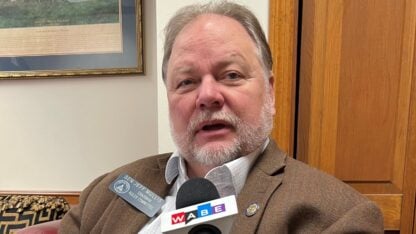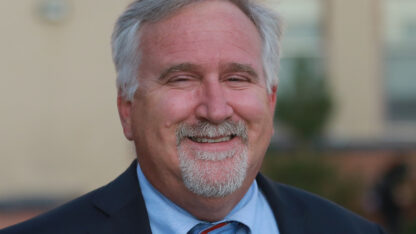How Teachers Are Trying To Help Students Identify ‘Real’ News

Teachers say their students are often tech-savvy, but that doesn’t necessarily translate to being media-savvy.
Damian Dovarganes / Associated Press file
When a story pops up on social media with an outrageous headline, it can often take a few minutes to realize it is not from a credible source. New research from the Reboot Foundation shows it’s a problem for kids as well as adults.
More than one-third of eighth-graders in the U.S. say they “rarely” or “never” learn how to judge the reliability of sources, according to data from the National Center for Education Statistics (NCES).
Spotting The Truth
Teachers say their students are often tech-savvy, but that doesn’t necessarily translate to being media-savvy.
Alison Eber teaches fourth grade in the City Schools of Decatur. She introduces her students to made-up news by showing them a website called “All About Explorers.”

“It looks like a very credible, reasonable site until you actually start to read it and you learn outlandish facts like Columbus was born in the 1950s and was on ‘Oprah’ after he discovered America,” she says.
To help her students tell the difference between real and fictitious news sources, Eber plays a game with them called “Two Truths and a Lie.” She gives her students two articles from credible sources. They have to make up the third story — the lie — themselves. They present all three to the class who has to guess which stories are true and which is the lie.
“At the beginning, the kids start to write these really outlandish articles, and it’s pretty obvious which ones are the truth and which one is the lie,” she says.
With practice, Eber says, the kids start to get craftier. They realize making subtle changes to actual news stories can hide the lie.
“Then, they get better at the game, but it also helps them to see authors can do that and that it’s important to look at things like evidence,” she says.
Eber also teaches her kids to check sources to see if they’re credible.
She has them ask: Is the source well-known? They also have to verify the content of an article with other sources. Eber says it’s important that students understand the difference between news from a source like National Geographic versus The National Enquirer.
Research In The Modern Era
Those can be hard skills to teach in an environment where a lot of people get their news from social media, says Darren Crovitz. He’s the director of English Education at Kennesaw State University and a professor in the department.
Crovitz says conducting research in the modern era means people are more likely to look a topic up on their phone than to take the trouble to research it in a library, where sources have already been vetted.
We shouldn’t all just step back and hope that [fake news] goes away or that the tech companies figure it out. We all society-wise have a role.”
Helen Lee Bouygues, founder of The Reboot Foundation
“That puts the burden on the individual person to know, ‘How do I know what I’m reading is credible?’” Crovitz says. “’What’s kind of like the algorithm can I bring to that? How do I check this source? How do I check someone’s credibility? How do I know this is authentic or inauthentic?’”
Crovitz teaches future high school English teachers. He says English teachers are usually responsible for teaching media literacy, but it should probably be taught separately.
“I think that all seniors, for instance, in the state, should be taking a digital media analysis and creation course,” he says.
The creation piece is important, Crovitz says, because, in addition to having access to a wide array of information on their phones, students can also create content quickly and distribute it through networks that don’t have guardrails in place.
“We don’t have the traditional kinds of experts saying, ‘Well, this doesn’t count as a fact,’ or ‘This hasn’t really been backed up as a claim,’ that we used to have with legacy media 20 or 30 years ago,” Crovitz says.

Some states have developed their own media literacy standards for schools. Georgia isn’t one of them. However, the state does follow the Common Core State Standards in English/Language Arts, which contains some media literacy standards.
‘We All … Have A Role’
Helen Lee Bouygues, the founder of The Reboot Foundation, authored the group’s recent report on media literacy. She says there’s evidence that interventions, like the work Crovitz and Eber are doing, have an effect.
“There is an impact directly in terms of benefits of people being able to spot faster and spot more accessibly fake news,” Bouygues says. “So that special effort of having the medium of education available, there is a positive correlation.”
Bouygues says because fictitious news and questionable sources are so prevalent, kids need to be taught to think critically so they can become responsible consumers of news.
“We shouldn’t all just step back and hope that this thing goes away or that the tech companies figure it out,” she says. “We all society-wise have a role. If we continue to help educate early on critical thinking to our children, challenging assumptions, asking, ‘Who’s the creator?’ ‘What is the message?’ That will all help children, as they grow older, be less susceptible to fake news.”
Click here to see Alison Eber’s webinar on digital literacy in grades K-5.
Click here to see Darren Crovitz’s webinar on digital literacy for grades 6-12.








